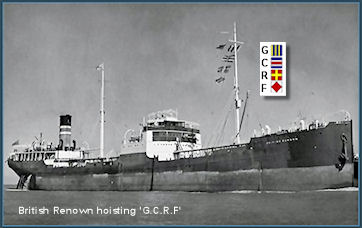

In 1817 the Board of Trade formed a committee to devise a better method of ship identification. This was to replace the earlier system devised by Captain Maryatt based on numerals which had proved to be too cumbersome. The result was a four letter code to be allocated to each ship and was to be flown as flags in a single hoist. Since initially most entries were sailing vessels, steamships were identified by the addition of an obolus (†). This practice was discontinued around 1913. The codes were listed in the Mercantile Navy List together with details of the vessel, including the registration number, making it easy to identify the vessel by reference to the list. It enabled officers at Signal Stations on shore and masters of ships at sea to signal and report passing ships. When a vessel was sold or subject to a name change, it retained the same signal letters. Only when a ship was disposed of or lost were the signal letters reallocated. The system was available to all mercantile ships and the list, revised and published annually, contained vessels from 1 net registered ton upwards. Prior to the 1927 Washington Radio Conference, signal letters were assigned on an ad hoc basis but they were subsequently reissued so that the first letter or the first and second letters of the visual signal group indicated the nationality of the ship. About this same time ships changed their flag/visual signal call sign and their wireless/radio call sign to one and the same. The following table shows the allocation of initial letters so far as British ships were concerned :-
During WW2 U-boats monitored the 600/800 meter band for distress signals to identify victims by their call signs. Also during WWII signal letters were sent by aldis lamp for visual communications especially as ships were under strict radio silence. Instructions explaining the use of signal letters were given on pages 5 and 6 of Volume I, of the 'International Code of Signals 1931'. In particular, signal letters would be hoisted in response to 'VH' (you should HOIST your signal letters) or 'NNJ' (you should MAKE your signal letters i.e. by any means). The system continued to be used until 1947 when it was replaced by the modern alphanumeric call sign. |
This database contains:
![]() 11,033 entries from the 1912 edition, Part I (corrected to Dec. 31, 1911 )
11,033 entries from the 1912 edition, Part I (corrected to Dec. 31, 1911 )
![]() 121 entries from the 1912 edition, Part I Supplement (corrected to April 1, 1912). The only publication to include the Titanic.
121 entries from the 1912 edition, Part I Supplement (corrected to April 1, 1912). The only publication to include the Titanic.
![]() 10,961 entries from the 1916 edition, Part I (corrected to Dec. 31, 1915 )
10,961 entries from the 1916 edition, Part I (corrected to Dec. 31, 1915 )
![]() 8,168 entries from the 1938 edition, Part I (corrected to Dec. 31, 1937 )
8,168 entries from the 1938 edition, Part I (corrected to Dec. 31, 1937 )
![]() 42 entries from the 1938 edition, Part I Supplement (corrected to Dec. 31, 1937)
42 entries from the 1938 edition, Part I Supplement (corrected to Dec. 31, 1937)
![]() 9,701 entries from the 1945 edition, Part I (corrected to Dec. 31, 1944) and
9,701 entries from the 1945 edition, Part I (corrected to Dec. 31, 1944) and
![]() 930 entries from the December 1945, Part I Supplement (new entries from Jan. 1, 1945 - Dec. 31, 1945).
930 entries from the December 1945, Part I Supplement (new entries from Jan. 1, 1945 - Dec. 31, 1945).
While every effort has been made to preserve the accuracy of the data, no warranty is given and the original
documents should be consulted where possible. Please be aware that there are many typographical errors
in the original documents together with poorly printed and malformed type. These have not been completely corrected in this database.
Thanks are due to Spud Roscoe of Canada for much additional information